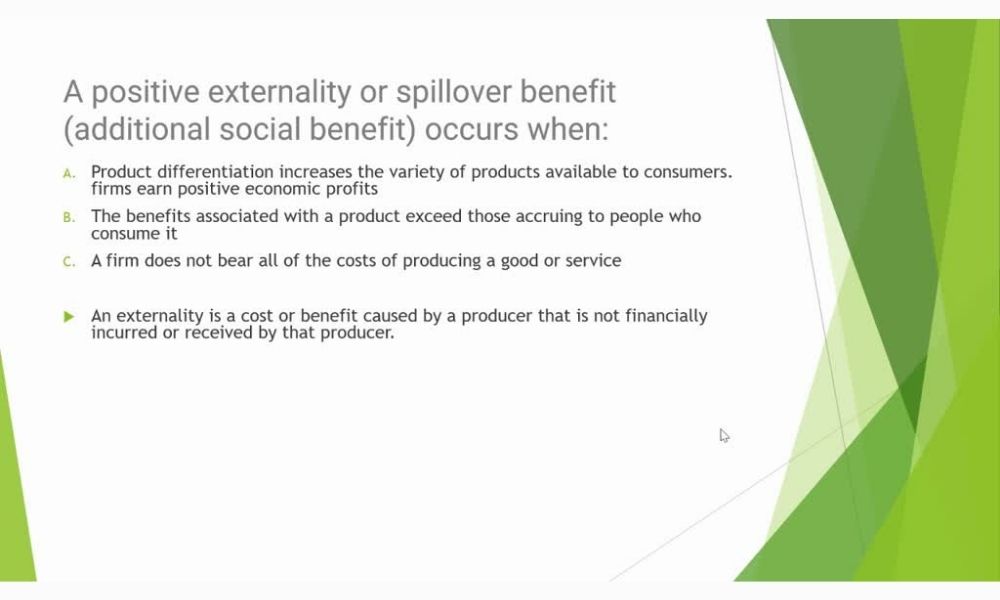In economics, externalities refer to the unintended consequences of economic activities that affect third parties who are not directly involved in the transaction. These externalities can be either positive or negative, depending on whether they bring benefits or harm to the third parties. A positive externality, also known as a spillover benefit, occurs when the actions of one party result in benefits for others without any compensation. This article will explore the concept of positive externalities, their causes, and their impact on the economy and society.
Contents
Understanding Positive Externalities
Positive externalities occur when the production or consumption of a good or service generates benefits for individuals or society that are not reflected in the market price. In other words, the benefits of the good or service spill over to third parties who are not involved in the transaction. These externalities can arise in various forms, such as knowledge spillovers, technology spillovers, and network effects.
For example, when a company invests in research and development to create a new technology, the benefits of that technology can spill over to other companies and industries. These companies can then use the technology to improve their own products and services, leading to increased productivity and economic growth. Similarly, when a person gets vaccinated against a contagious disease, not only do they protect themselves, but they also protect others around them, creating a positive externality.
Read:What is a flex benefits card?Causes of Positive Externalities
There are several reasons why positive externalities occur. One of the main reasons is the presence of public goods. Public goods are non-excludable and non-rival in consumption, meaning that once they are provided, it is impossible to exclude anyone from using them, and one person’s consumption does not reduce the amount available for others. Examples of public goods include national defense, street lighting, and public parks.
Since public goods are not provided by the market, the government often steps in to provide them. However, the benefits of public goods spill over to individuals who do not contribute to their provision, creating a positive externality. For instance, when the government invests in building a public park, the benefits of the park are not limited to the people who pay taxes to fund it. Everyone in the community can enjoy the park, regardless of whether they contributed to its construction or not.
Another cause of positive externalities is the presence of knowledge spillovers. Knowledge spillovers occur when the knowledge or skills acquired by one person or company spill over to others, leading to increased productivity and innovation. For example, when a company invests in training its employees, the skills and knowledge gained by those employees can spill over to other companies in the same industry, leading to improved productivity and competitiveness.
Read:what are the benefits of aarpExamples of Positive Externalities
Positive externalities can be found in various industries and activities. One of the most well-known examples is education. Education is considered a positive externality because it not only benefits the individual receiving it but also society as a whole. Educated individuals are more likely to have higher-paying jobs, leading to increased tax revenue for the government. They are also more likely to make informed decisions and contribute positively to society.
Another example of a positive externality is the use of renewable energy sources. When individuals or companies invest in renewable energy sources such as solar panels or wind turbines, they not only reduce their own carbon footprint but also contribute to reducing air pollution and mitigating the effects of climate change for everyone in the community.
Technology is another area where positive externalities are prevalent. The development of new technologies often leads to knowledge spillovers, which can benefit other companies and industries. For instance, the development of the internet has led to knowledge spillovers in various fields, such as e-commerce, online education, and telemedicine.
Impact of Positive Externalities
Positive externalities have a significant impact on the economy and society. They can lead to increased economic growth, improved living standards, and a more efficient allocation of resources. When positive externalities are present, the market fails to capture the full value of the good or service, leading to underproduction or underconsumption. This can result in a suboptimal allocation of resources, where society is not fully benefiting from the positive externalities.
Read:what benefits does a child get if a parent diesMoreover, positive externalities can also lead to market failures, where the market fails to provide the optimal level of the good or service. This is because the market does not take into account the benefits that spill over to third parties. As a result, the government may need to intervene to correct these market failures and ensure that the positive externalities are fully realized.
Addressing Positive Externalities
There are several ways to address positive externalities and ensure that they are fully realized. One approach is through government intervention, such as providing subsidies or tax incentives to encourage the production or consumption of goods and services that generate positive externalities. For example, the government may provide tax credits to companies that invest in research and development or offer subsidies to individuals who install solar panels on their homes.
Another approach is through the use of property rights and market-based solutions. Property rights can be used to internalize positive externalities by giving individuals or companies the right to charge for the use of their knowledge or technology. This can incentivize them to invest in research and development and share their knowledge with others, leading to increased innovation and productivity.
Market-based solutions, such as cap-and-trade systems, can also be used to address positive externalities. These systems put a limit on the amount of pollution that companies can emit and allow them to trade their emission permits with other companies. This creates a financial incentive for companies to reduce their emissions and invest in cleaner technologies, leading to positive externalities for society.
Conclusion:
In conclusion, positive externalities or spillover benefits occur when the actions of one party result in benefits for others without any compensation. These externalities can arise due to the presence of public goods, knowledge spillovers, and network effects. They have a significant impact on the economy and society, leading to increased economic growth, improved living standards, and a more efficient allocation of resources. To fully realize the benefits of positive externalities, governments may need to intervene through subsidies, tax incentives, or market-based solutions. By addressing positive externalities, we can create a more prosperous and sustainable future for all.









